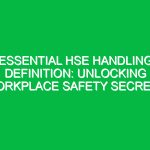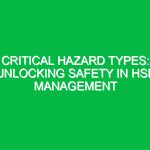Introduction
Hello Team,
Today, we’re gathering for a toolbox talk to discuss an essential topic that impacts our daily operations: the Questions to Ask Before a Work Task within the Health, Safety, and Environment (HSE) framework. Understanding the right questions to ask before commencing any work task is crucial for ensuring not only your Safety but also that of your colleagues.
As we dive into this topic, I encourage everyone to think critically about their work tasks and the associated risks. This discussion is designed to empower you to make informed decisions that contribute to a safer work environment. By the end of this talk, you’ll understand how asking the right questions can prevent accidents and enhance our operational efficiency.
The Importance of Asking Questions
Why is it important to ask questions before starting a work task? The answer is simple: it helps mitigate risks. Many accidents occur due to a lack of awareness or oversight regarding potential Hazards. By fostering a culture where questions are encouraged, we not only enhance our Safety practices but also promote a proactive approach to HSE compliance.
Understanding the Context of Your Work
Before beginning any task, it’s vital to understand the context in which you are working. This involves recognizing the environment, the tools you’ll be using, and the potential risks associated with the task. Here are some key questions to consider:
- What is the specific task I am about to perform?
- What are the potential Hazards associated with this task?
- Do I have the necessary Training and experience to perform this task safely?
- What Personal Protective Equipment (PPE) do I need to wear?
- Are there specific Procedures or protocols I must follow?
Asking these questions helps clarify your understanding of the task and the associated risks, setting the foundation for safe work practices.
Identifying Hazards
Identifying hazards is a critical step in the HSE process. Hazards can be physical, chemical, biological, ergonomic, or psychosocial. Let’s break this down further:
Types of Hazards
- Physical Hazards: These include anything that can cause harm through contact, such as machinery, tools, or environmental conditions.
- Chemical Hazards: Exposure to harmful substances can occur through inhalation, skin contact, or ingestion. Always check Safety Data Sheets (SDS) for chemicals you might be using.
- Biological Hazards: These are related to exposure to harmful organisms, such as bacteria or viruses, particularly in environments like healthcare or laboratory settings.
- Ergonomic Hazards: These involve the physical strain on the body, often leading to musculoskeletal disorders, especially in repetitive or heavy lifting tasks.
- Psychosocial Hazards: These include stress, harassment, or any other workplace conditions that may affect mental health.
By identifying these hazards upfront, you can better prepare yourself and your team to mitigate risks effectively.
Questions to Identify Hazards
Here are some questions to ask when identifying hazards:
- What are the potential risks involved in this task?
- Have there been any near-misses or incidents related to this task in the past?
- What environmental factors could affect the safety of this task?
- What tools or equipment might pose a risk, and how can I minimize that risk?
Assessing Risks
Once you’ve identified potential hazards, the next step is risk assessment. This means evaluating the likelihood and severity of each identified hazard. Here’s how you can effectively assess risks:
Risk Assessment Process
- Identify the Hazard: Clearly define what the hazard is.
- Evaluate the Risk: Consider how likely it is that harm will occur and what the potential consequences are.
- Implement Control Measures: Determine how to eliminate or reduce the risk, such as introducing engineering controls, administrative changes, or PPE.
- Review and Monitor: Continuously monitor the effectiveness of your Control Measures and make adjustments as necessary.
This structured approach to risk assessment ensures that you’re not just identifying hazards but also taking proactive steps to manage them effectively.
Questions for Risk Assessment
Here are some questions to ask during your risk assessment:
- What is the likelihood of an incident occurring, and what factors contribute to that likelihood?
- If an incident were to occur, what would be the potential impact on myself and my colleagues?
- What measures can I implement to reduce the risk associated with this task?
- Are there any procedures in place that I should be familiar with to manage these risks?
Planning for Safety
Planning is essential for safety in the workplace. Proper planning takes into account the hazards and risks identified earlier. This is where we develop a clear plan of action to execute the task safely.
Elements of Effective Planning
- Task Breakdown: Break down the task into manageable steps and consider the associated risks at each step.
- Resource Allocation: Ensure you have access to the necessary tools and resources to perform the task safely.
- Team Communication: Discuss the plan with your team and ensure everyone understands their roles and responsibilities.
- Emergency Preparedness: Have a plan in place for emergencies, including first aid and Evacuation Procedures.
Questions for Planning
When planning for safety, consider these questions:
- What are the steps involved in completing this task safely?
- Who else will be involved, and how can we ensure effective communication?
- What contingency plans do we need in case something goes wrong?
- Are there specific safety protocols that must be followed during this task?
Training and Competence
Before starting any task, it’s crucial to ensure that everyone involved is adequately trained. This not only includes formal training but also on-the-job learning and mentorship.
Importance of Training
Training equips employees with the knowledge and skills necessary to perform their tasks safely. Regular training sessions keep safety practices fresh in everyone’s mind and help reinforce the importance of asking questions.
Questions Regarding Training
When assessing training needs, consider these questions:
- Have I received adequate training for this specific task?
- What additional training might be beneficial for me and my colleagues?
- Are there opportunities for mentorship or guidance during this task?
- How can I ensure that I am up to date with the latest safety protocols?
Creating a Culture of Safety
Asking questions is just one piece of the puzzle. To truly promote safety, we need to cultivate a culture where everyone feels empowered to speak up and share their concerns. This involves encouraging open dialogue and actively listening to feedback.
Encouraging Communication
Regular Toolbox Talks are a great way to foster communication. They provide a platform for discussing safety concerns, sharing experiences, and collectively brainstorming solutions. Here are some ways to encourage communication:
- Hold regular meetings to discuss safety issues.
- Encourage team members to share their experiences and insights.
- Create an anonymous reporting system for safety concerns.
- Recognize and reward Safe Practices within the team.
Discussion Questions
To encourage engagement, consider these discussion questions:
- What safety concerns do you think we should address in our next Toolbox Talk?
- Can anyone share an experience where asking questions helped prevent an incident?
- How can we improve our communication regarding safety?
Regulations and Standards
Compliance with Regulations and safety standards is not just a legal obligation; it’s a moral one. Understanding the laws that govern our work helps us maintain a safe environment and protects us from potential legal repercussions.
Relevant Regulations
Familiarize yourself with the regulations relevant to our industry, including:
- Occupational Safety and Health Administration (OSHA) standards
- Environmental Protection Agency (EPA) guidelines
- Local and state regulations that may apply to our operations
Compliance with these regulations impacts our safety practices and legal obligations. Always keep them in mind as you prepare for your work tasks.
Conclusion
In conclusion, the Questions to Ask Before a Work Task are vital in promoting a culture of safety within our workplace. By asking the right questions, identifying hazards, assessing risks, and planning effectively, we can significantly reduce the likelihood of accidents and injuries.
Remember, safety is everyone’s responsibility. Your active participation in these discussions and your commitment to asking questions will help us maintain a safe working environment. Thank you for your attention today and for your ongoing commitment to safety. Let’s make our workplace safer together!


